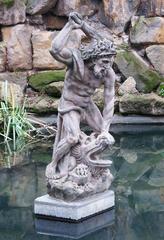
Statue of Hercules Prague: Visiting Hours, Tickets & Historical Guide
Date: 14/06/2025
Introduction
The Statue of Hercules, located in the tranquil Wallenstein Garden of Prague’s Malá Strana district, is a striking example of Baroque sculpture and classical mythology. This iconic monument, a faithful reproduction of Adriaen de Vries’ early 17th-century masterpiece, stands as a testament to the city’s artistic heritage and its enduring ties to European culture. Commissioned by the powerful Albrecht von Wallenstein, the statue symbolizes strength and heroism, set amid a lush garden landscape rich with history and mythological references. This comprehensive guide offers essential information on visiting hours, ticketing, accessibility, and cultural insights to help you make the most of your visit to this significant Prague landmark (prague.net, delveintoeurope.com, fromplacetoplace.travel).
Table of Contents
- Introduction
- Historical and Artistic Context
- Mythological Significance
- Wallenstein Garden: History and Features
- Artistic Details and Restoration
- Visiting Information: Hours, Tickets & Accessibility
- Cultural and Symbolic Importance
- The Statue in Prague’s Sculpture Heritage
- Events & Modern Use
- Frequently Asked Questions (FAQ)
- Plan Your Visit
- Further Reading & Sources
Historical and Artistic Context
The Statue of Hercules is a highlight of Wallenstein Garden (Valdštejnská zahrada), which was constructed between 1623 and 1630 as part of the Wallenstein Palace complex. Designed in the early Baroque style with strong Italian influences, the garden and its sculptures were commissioned to rival European royal residences (prague.net).
Adriaen de Vries, a Dutch Mannerist sculptor renowned for his expressive, dynamic figures, created the original bronze sculptures for the garden. In 1648, Swedish troops looted the original statues during the Thirty Years’ War, moving them to Drottningholm Palace, Sweden. High-quality replicas were installed between 1912 and 1918, ensuring de Vries’ legacy remains accessible to Prague’s visitors (theworldisabook.com).
Mythological Significance
Hercules (Herakles in Greek mythology) embodies strength, perseverance, and virtue—qualities celebrated during the Baroque era. The statue, depicted in a dramatic pose with naiads (water nymphs), is positioned on an islet in the garden’s pond, symbolically linking the hero to the natural and mythological world (prague.net).
This representation reflects the Baroque fascination with antiquity, using mythological figures to convey philosophical ideals and political messages. For Wallenstein, commissioning such works asserted his power and intellect.
Wallenstein Garden: History and Features
Wallenstein Garden was designed to impress and demonstrate the wealth of its patron. Following Italian Renaissance and Baroque principles, it features symmetrical parterres, ornamental ponds, and a grand pavilion (Sala Terrena) adorned with frescoes of the Trojan War by Baccio di Bianco (theworldisabook.com). Originally, the garden showcased an extensive collection of mythological bronze statues, most of which were taken during the 1648 looting; today, high-quality replicas restore much of its original grandeur.
Artistic Details and Restoration
The present Statue of Hercules is a marble reproduction, capturing the muscular tension and movement characteristic of Baroque sculpture. Set on a small island amidst water, ducks, and aquatic plants, it is a favorite spot for photography and reflection (theworldisabook.com).
The garden and its statues have undergone restoration since the early 20th century and are now maintained by the Czech Senate, preserving their historical integrity and accessibility for the public.
Visiting Information: Hours, Tickets & Accessibility
- Location: Wallenstein Garden, Malá Strana, Prague
- Opening Hours: April–October, typically daily from 7:00 or 10:00 AM to 5:00–7:00 PM (seasonal variation; check prague.net or Senat.cz for updates)
- Tickets: Admission is free; some events may require tickets.
- Accessibility: Most paths are accessible, but some historic surfaces may be uneven.
- Facilities: Restrooms and a café are available; photography is permitted for personal use (Senat.cz).
- Travel Tips: Easily reached from Malostranská metro/tram, and close to Prague Castle and Charles Bridge.
Cultural and Symbolic Importance
The Statue of Hercules is more than a decorative feature; it is a symbol of Prague’s resilience and a tangible link to its Baroque and mythological heritage (discoveringprague.com). The garden’s sculptures and design highlight the city’s cosmopolitan role in European art and its commitment to public cultural spaces.
The Statue in Prague’s Sculpture Heritage
Prague is renowned for its diverse public art, from the medieval saints on Charles Bridge to contemporary works. The Wallenstein Garden’s mythological sculptures, including Hercules, reflect an era of artistic innovation and cosmopolitan influence (culturaobscura.com, delveintoeurope.com).
Events & Modern Use
Wallenstein Garden serves as a venue for cultural events, concerts, and Senate ceremonies, with the Hercules statue often acting as a dramatic focal point (prague.net). The garden’s peacocks, lush landscape, and historical ambiance make it a favorite for both tourists and locals.
Frequently Asked Questions (FAQ)
Q: What are the visiting hours for the Statue of Hercules and Wallenstein Garden?
A: Usually April–October, daily from 7:00/10:00 AM to 5:00/7:00 PM, but hours vary seasonally.
Q: Is there an entrance fee?
A: No, entry is free.
Q: Is the garden accessible for wheelchairs?
A: Most paths are accessible, but certain areas may be uneven.
Q: Are guided tours available?
A: Occasionally during special events or through local operators.
Q: Can I take photographs?
A: Yes, personal photography is allowed.
Plan Your Visit
To fully enjoy your experience, check current opening hours and events on official websites. Combine your visit with other Malá Strana attractions, and consider using the Audiala app for guided audio tours and updates on Prague’s cultural events. Respect garden rules to preserve this tranquil landmark for future generations.
Further Reading & Sources
- Wallenstein Garden, Prague.net
- Prague Gardens Guide, Delve Into Europe
- Wallenstein Garden, Senat.cz
- Wallenstein Garden, From Place to Place
For more on Prague’s historical sites and travel tips, explore our related articles and download the Audiala app for exclusive content.























































































































































































